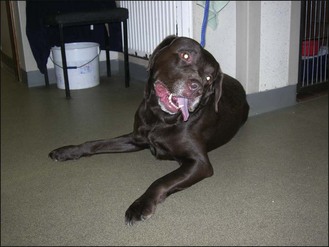58 Loss of balance
CLINICAL EXAMINATION
The dog was alert, ambulatory and had a normal gait. Hopping and proprioception were also normal. A spontaneous rotatory nystagmus with the fast phase to the right, slight positional ventral strabismus of the left eye and a left head tilt were present (Fig. 58.1). The left upper lip appeared to droop, owing to the left head tilt. Facial muscle function was normal bilaterally. Facial sensation was present bilaterally.
NEUROANATOMICAL DIAGNOSIS
The lesion was localized to the left peripheral vestibular apparatus – the inner ear to affect both the cochlear duct and semicircular canals given the inability to localize sound as well as the loss of balance or the surface of the brainstem where the left CN VIII enters (Table 58.1).
Table 58.1 Differentiation of central and peripheral vestibular disease
| Peripheral | Central | |
|---|---|---|
| Nystagmus (type) | Stay updated, free articles. Join our Telegram channel
Full access? Get Clinical Tree
 Get Clinical Tree app for offline access
Get Clinical Tree app for offline access

|
